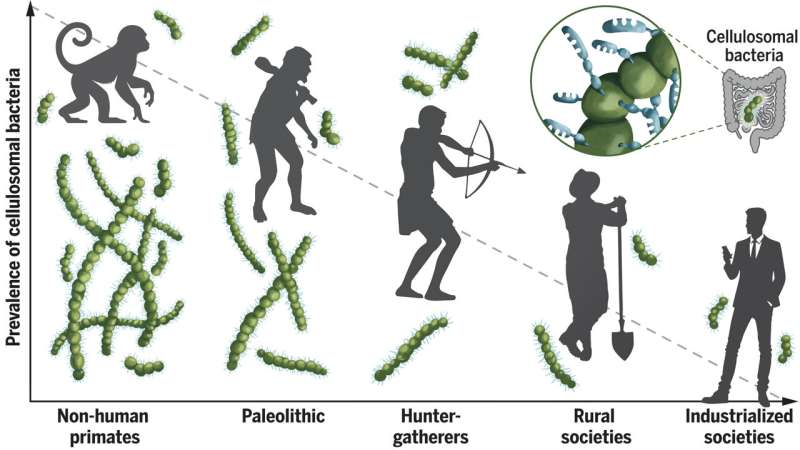March 15, 2024 report
This article has been reviewed according to Science X's editorial process and policies. Editors have highlighted the following attributes while ensuring the content's credibility:
fact-checked
peer-reviewed publication
trusted source
proofread
Research team identifies three bacteria species in the human gut that can break down cellulose

An international team of biotechnologists and evolutionary specialists has discovered three types of bacteria in the human gut that help to break down cellulose. In their project, reported in the journal Science, the group studied the genomes of bacteria found in human and ruminates.
For many years, it was believed that the modern human diet had rid the gut of the ability to digest cellulose (the prime component of plant cell walls). But in 2003, a team of researchers discovered a cellulose-eating bacteria in human fecal samples. Since that study, it has not been known whether there are more types of bacteria in the human gut capable of aiding in digesting plant material. In this new study, the research team conducted an exhaustive study of gut bacteria genomes.
The researchers studied gut bacteria samples collected from humans and a variety of ruminates. They also included study of fecal samples left by early humans approximately 1,000 years ago. Their work involved sequencing and computer analysis of bacterial DNA from the samples. The team looked for overlaps between ruminates and humans as a way to identify bacteria capable of breaking down cellulose.
They found three types of bacteria that produce cellulases when they come into contact with plant material. Such enzymes are known to be able to break down cellulose.
The researchers also found that the frequency of plant-digesting bacteria in the gut has dropped dramatically in people who eat a modern diet. They found, for example, levels as high as 30% to 40% in non-human primates and humans from 1,000 years ago, and 20% in modern hunter–gatherer people. In sharp contrast, they found that those eating a modern diet showed levels less than 5%.
The research team suggests that because the human gut still contains some cellulose-processing bacteria, those wishing to reap the benefits of eating more plant material could obtain some benefit from probiotics, which may increase the frequency of gut bacteria that breaks down cellulose.
More information: Sarah Moraïs et al, Cryptic diversity of cellulose-degrading gut bacteria in industrialized humans, Science (2024). DOI: 10.1126/science.adj9223
Journal information: Science
© 2024 Science X Network





















